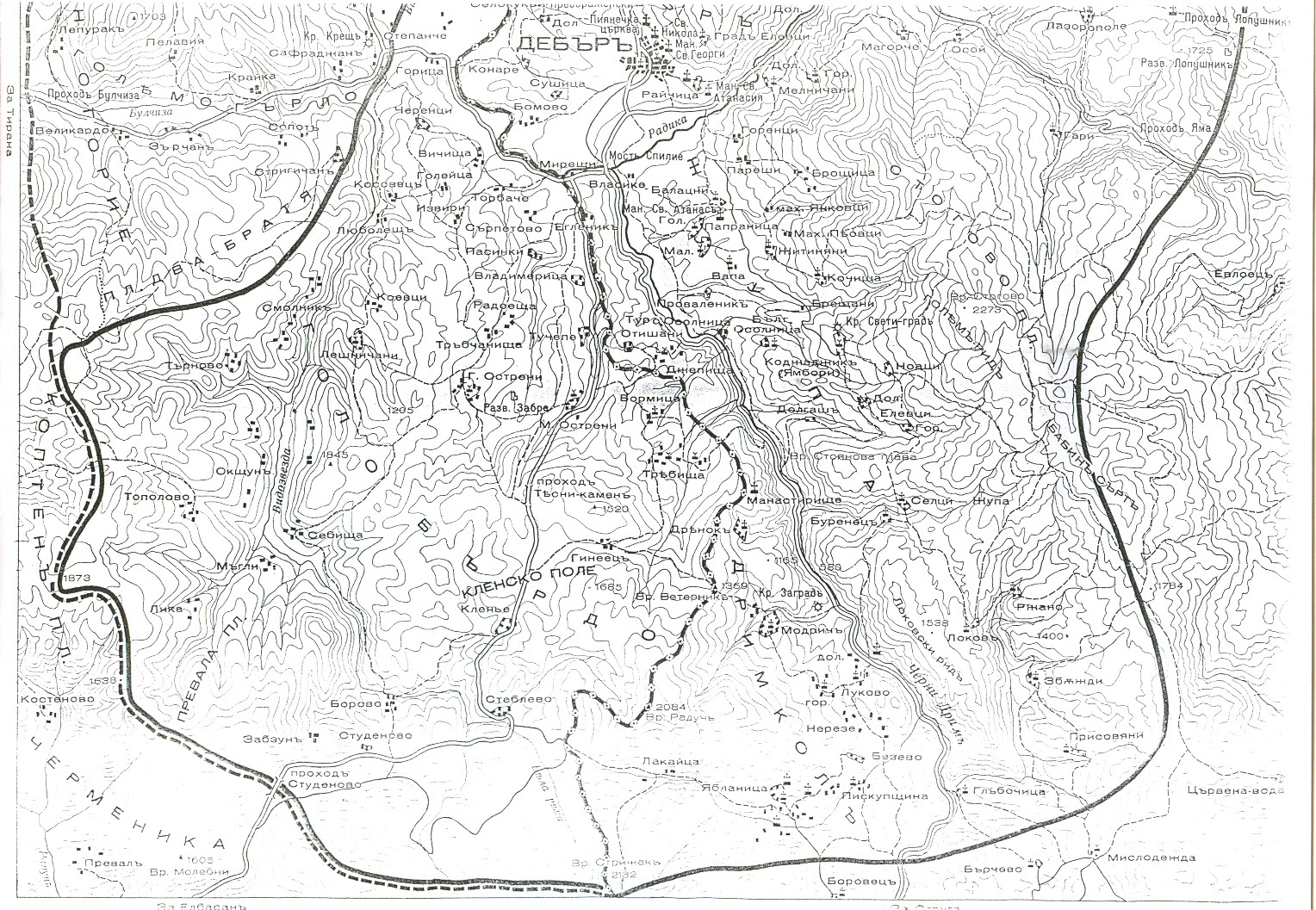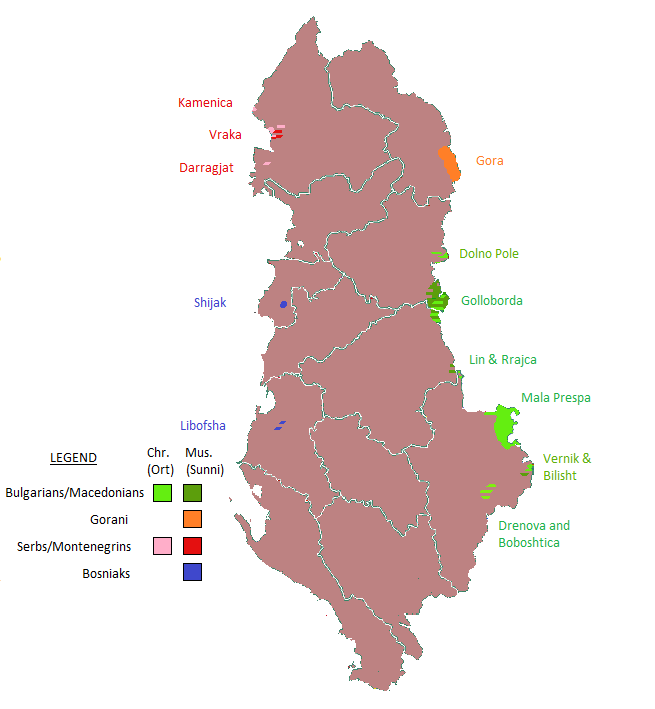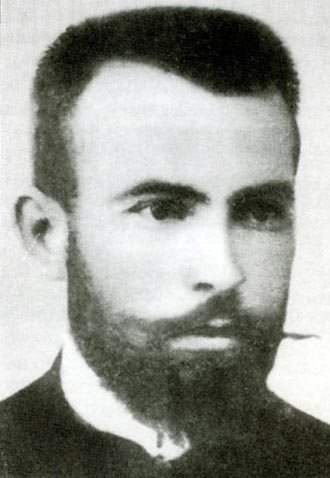|
Gollobordë
Gollobordë ( sq-definite, Golloborda, bg, Голо Бърдо/Golo Bărdo, mk, Голо Брдо/Golo Brdo) refers to a geographical area of traditionally 24 villages of which 18 are situated primarily in eastern Albania, with a small portion consisting of six villages lying within North Macedonia. This region is located within the Dibër and Elbasan counties which contain both Macedonian and Albanian villages. This region, like neighboring regions, has historically been economically linked to the city of Debar, which was traditionally referred to by inhabitants as simply "the City". History Ottoman period The Islamization process is held to have occurred in Golloborda relatively late in Ottoman times.Toncheva, Veselka (2013). "The Slavonic Community from the Golo Bardo Region, Republic of Albania: Traditions, Music, Identity". ''Our Europe. Ethnography – Ethnology – Anthropology of Culture''. Volume 2. Pages 40–42 In 1519, the region was still entirely Christian.Lima ... [...More Info...] [...Related Items...] OR: [Wikipedia] [Google] [Baidu] |
Macedonians In Albania
The Macedonians in Albania ( mk, Македонци во Албанија, Makedonci vo Albanija; sq, Maqedonasit në Shqipëri) are an officially recognized ethnic minority. According to the 2011 census, 5,512 ethnic Macedonians live in Albania. In the 1989 census, 4,697 people had declared themselves Macedonian. In some circumstances, ethnic identity can be fluid among Albania's Slavophonic population, who may identify as Macedonian or Bulgarian, depending on the circumstances. Albanian Slavs are targeted by "Bulgarian cross-border nationalism" and, as an EU member, Bulgaria offers more benefits to this minority than Macedonia does. According to Edmond Temelko, former mayor of the Pustec Municipality, " ..Bulgaria uses heavy economic situation of Macedonians in Albania to offer them Bulgarian citizenship, passports and employment opportunity". The condition of the Macedonian population living in the Prespa area is described in positive terms and particular praise is given sinc ... [...More Info...] [...Related Items...] OR: [Wikipedia] [Google] [Baidu] |
Bulgarians In Albania
Ethnic Bulgarians in present-day Albania live mostly in the areas of Mala Prespa, Gollobordë and Gora. According to the Bulgarian State Agency for Bulgarians Abroad, 40,000 to 50,000 persons of Bulgarian origin are living in Albania. Ethnic identity can be fluid among the Albania's Slavophonic population, who might identify as Albanian, Bulgarian or Macedonian, depending on the circumstances.INTERNATIONAL CENTRE FOR MINORITY STUDIES AND INTERCULTURAL RELATIONS (IMIR)ALBANIA:LANDMARKS OF TRANSITION Valeri Grigorov p.18 Between 2001 and 2016, around 4,470 Albanian nationals applied for a Bulgarian citizenship and over 2,600 of them were granted one. The Bulgarian minority was recognized by the Albanian government in October 2017. History Middle Ages and Ottoman period The first reference to a Slavic presence in Albania dates to 548, when the Slavs reached Epidamnos (Durrës), capturing fortresses in the city's vicinity. Slavic settlement near Epirus in southern Albania is ment ... [...More Info...] [...Related Items...] OR: [Wikipedia] [Google] [Baidu] |
Klenjë
Klenjë ( mk, Клење) is a village in the former Trebisht Municipality in Dibër County in northeastern Albania. At the 2015 local government reform it became part of the municipality Bulqizë. It is situated with in the Gollobordë region, near the border with North Macedonia. History During the Balkan Wars, one man from the village joined the Macedonian-Adrianopolitan Volunteer Corps in Bulgarian Army. Demographic history Klenjë (''Kilani'') is recorded in the Ottoman ''defter'' of 1467 as a settlement in the timar of Hacı Hamza in the vilayet of Dulgoberda. The village had a total of three households represented by ''Dimitri Susjabi'' (possibly, ''Sycjapi''); ''Gjurçe'', the grandson or brother-in-law of ''Dimitri''; and ''Miho Tishani''. The surname ''Susjabi'' is likely a compound of Albanian ''sy'' ("eye") + ''cjap'' ("billy goat"). A Bulgarian demographic survey of the population of the village, done in 1873, recorded the village as having 100 households with ... [...More Info...] [...Related Items...] OR: [Wikipedia] [Google] [Baidu] |
Mala Prespa
Mala Prespa ( Macedonian and bg, Мала Преспа, ) is a term used to denote a geographical area in eastern Albania, part of the wider region of Prespa. It is located on the western shore of Lake Prespa along the southeastern edge of Albania within the wider Korçë County and bordering the Pogradec and Devoll municipalities. The area is synonymous with Pustec Municipality. It is officially recognised as a Macedonian minority zone. According to the 2011 Census, in Albania there are about 5,000 Macedonians, primarily in the Mala Prespa area, forming 97% of the population of the Pustec Municipality. This area also contains small numbers of Aromanians (''Arvanito-Vlachs'') and Bulgarians.Mediapool.bg 14.10.2017Албания призна българското национално малцинство./ref> See also *Macedonians in Albania *Bulgarians in Albania *Gollobordë Gollobordë ( sq-definite, Golloborda, bg, Голо Бърдо/Golo Bărdo, mk, Голо Брд ... [...More Info...] [...Related Items...] OR: [Wikipedia] [Google] [Baidu] |
Macedonian Muslims
The Macedonian Muslims ( mk, Македонци-муслимани, Makedonci-muslimani), also known as Muslim Macedonians or ''Torbeši'' ( mk, Торбеши), and in some sources grouped together with Pomaks, are a minority religious group within the community of ethnic Macedonians who are Sunni Muslims (with Sufi influences being widespread among the population). They have been culturally distinct from the majority Orthodox Christian Macedonian community for centuries, and are ethnically and linguistically distinct from the larger Muslim ethnic groups in the greater region of Macedonia: the Albanians, Turks and Romanis. However, some Torbeši also still maintain a strong affiliation with Turkish identity and with Macedonian Turks. The regions inhabited by these Macedonian-speaking Muslims are Debarska Župa, Poreče (Suva Gora), Dolni Drimkol (particularly enclosing the villages of Oktisi and Labuništa), Reka, and Golo Brdo (in Albania). Origins The Macedonian Muslims ... [...More Info...] [...Related Items...] OR: [Wikipedia] [Google] [Baidu] |
Stëblevë
Stëblevë ( bg, Стеблево, mk, Стеблево) is a village and a former municipality in the Elbasan County in eastern Albania. At the 2015 local government reform it became a subdivision of the municipality Librazhd. The population at the 2011 census was 809.2011 census results The municipal unit consists of the villages Borovë, Llangë, , Prodan, Sebisht, Steblevë and Zabzun. History Steblevë appears in the Ottoman '''' of 1467 as a village in the ...[...More Info...] [...Related Items...] OR: [Wikipedia] [Google] [Baidu] |
Macedonians (ethnic Group)
Macedonians ( mk, Македонци, Makedonci) are a nation and a South Slavs, South Slavic ethnic group native to the region of Macedonia (region), Macedonia in Southeast Europe. They speak Macedonian language, Macedonian, a South Slavic language. The large majority of Macedonians identify as Eastern Orthodox Christians, who speak a South Slavic language, and share a cultural and historical "Orthodox Byzantine–Slavic heritage" with their neighbours. About two-thirds of all ethnic Macedonians live in North Macedonia and there are also Macedonian diaspora, communities in a number of other countries. The concept of a Macedonian ethnicity, distinct from their Orthodox Balkan neighbours, is seen to be a comparatively newly emergent one. The earliest manifestations of an incipient Macedonian identity emerged during the second half of the 19th century among limited circles of Slavic-speaking intellectuals, predominantly outside the region of Macedonia. They arose after the Firs ... [...More Info...] [...Related Items...] OR: [Wikipedia] [Google] [Baidu] |
South Slavic Languages
The South Slavic languages are one of three branches of the Slavic languages. There are approximately 30 million speakers, mainly in the Balkans. These are separated geographically from speakers of the other two Slavic branches (West and East) by a belt of German, Hungarian and Romanian speakers. History The first South Slavic language to be written (also the first attested Slavic language) was the variety of the Eastern South Slavic spoken in Thessaloniki, now called Old Church Slavonic, in the ninth century. It is retained as a liturgical language in Slavic Orthodox churches in the form of various local Church Slavonic traditions. Classification The South Slavic languages constitute a dialect continuum. Serbian, Croatian, Bosnian, and Montenegrin constitute a single dialect within this continuum. *Eastern ** Bulgarian – (ISO 639-1 code: bg; ISO 639-2 code: bul; SIL code: bul; Linguasphere: 53-AAA-hb) ** Macedonian – (ISO 639-1 code: mk; ISO 639-2(B) code: mac; IS ... [...More Info...] [...Related Items...] OR: [Wikipedia] [Google] [Baidu] |
Macedonian Language
Macedonian (; , , ) is an Eastern South Slavic language. It is part of the Indo-European language family, and is one of the Slavic languages, which are part of a larger Balto-Slavic branch. Spoken as a first language by around two million people, it serves as the official language of North Macedonia. Most speakers can be found in the country and its diaspora, with a smaller number of speakers throughout the transnational region of Macedonia. Macedonian is also a recognized minority language in parts of Albania, Bosnia and Herzegovina, Romania, and Serbia and it is spoken by emigrant communities predominantly in Australia, Canada and the United States. Macedonian developed out of the western dialects of the East South Slavic dialect continuum, whose earliest recorded form is Old Church Slavonic. During much of its history, this dialect continuum was called "Bulgarian", although in the 19th century, its western dialects came to be known separately as "Macedonian". Stan ... [...More Info...] [...Related Items...] OR: [Wikipedia] [Google] [Baidu] |
Džepište
Džepište ( mk, Џепиште, sq, Zhepisht) is a village in the municipality of Debar, North Macedonia. History In 1913 the village, along with other settlements on the left bank of the Black Drin, were assigned to Independent Albania. The village was part of the Principality of Albania from 1914-1925 and the Albanian Republic in 1925. It was ceded to the Kingdom of Serbs, Croats and Slovenes on 30 July 1925 by Ahmet Zogu. Demographics Džepište has traditionally been inhabited by Orthodox Macedonians and Muslim Macedonians. p. 214. "Заедно со македонско христијанско население Торбеши живеат и во селата: Могорче, Требиште, Велебрдо, Ростуше, Јанче, Долно Косоврасти (во Река), Горенци, Житинени (во Жупа), Џепиште," As of the 2021 census, Džepište had 347 residents with the following ethnic composition: *Turks 181 *Albanians 75 ... [...More Info...] [...Related Items...] OR: [Wikipedia] [Google] [Baidu] |
Debar Municipality
Debar ( mk, Дебар , sq, Komuna e Dibrës) is a municipality in western part of Republic of North Macedonia. ''Debar'' is also the name of the town where the municipal seat is found. Debar Municipality is part of the Southwestern Statistical Region. Geography The municipality borders Mavrovo and Rostuša Municipality to the northeast, Kičevo Municipality to the southeast, Centar Župa Municipality to the south, and Albania to the west. Demographics According to the last national census from 2021 this municipality has 15,412 inhabitants. Ethnic groups in the municipality include: * Albanians = 8,438 (54.75%) * Macedonians = 1,155 (7.49%) *Turks = 2,733 (17.73%) *Roma Roma or ROMA may refer to: Places Australia * Roma, Queensland, a town ** Roma Airport ** Roma Courthouse ** Electoral district of Roma, defunct ** Town of Roma, defunct town, now part of the Maranoa Regional Council *Roma Street, Brisbane, a ... = 1,140 (7.4%) *Others = 432 (2.8%) *Persons of whom dat ... [...More Info...] [...Related Items...] OR: [Wikipedia] [Google] [Baidu] |






